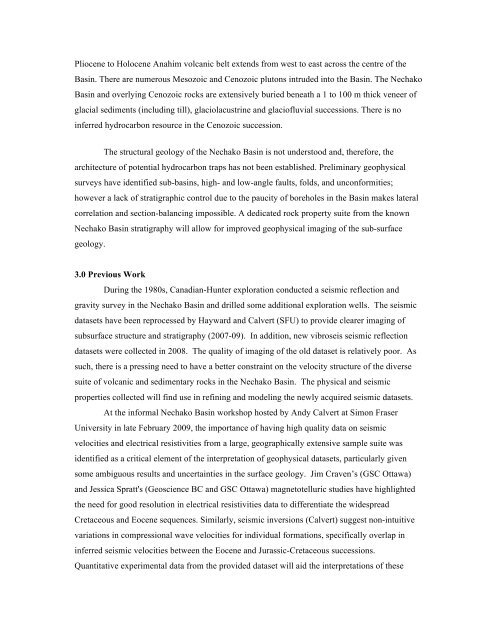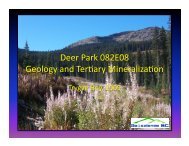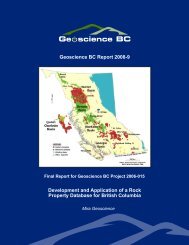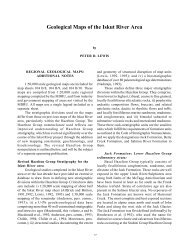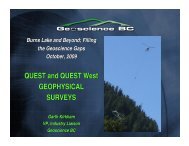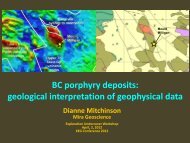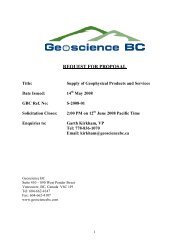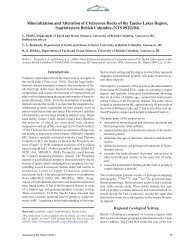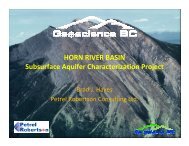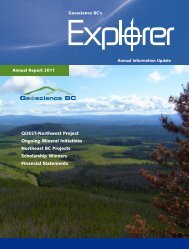Report - Geoscience BC
Report - Geoscience BC
Report - Geoscience BC
Create successful ePaper yourself
Turn your PDF publications into a flip-book with our unique Google optimized e-Paper software.
Pliocene to Holocene Anahim volcanic belt extends from west to east across the centre of the<br />
Basin. There are numerous Mesozoic and Cenozoic plutons intruded into the Basin. The Nechako<br />
Basin and overlying Cenozoic rocks are extensively buried beneath a 1 to 100 m thick veneer of<br />
glacial sediments (including till), glaciolacustrine and glaciofluvial successions. There is no<br />
inferred hydrocarbon resource in the Cenozoic succession.<br />
The structural geology of the Nechako Basin is not understood and, therefore, the<br />
architecture of potential hydrocarbon traps has not been established. Preliminary geophysical<br />
surveys have identified sub-basins, high- and low-angle faults, folds, and unconformities;<br />
however a lack of stratigraphic control due to the paucity of boreholes in the Basin makes lateral<br />
correlation and section-balancing impossible. A dedicated rock property suite from the known<br />
Nechako Basin stratigraphy will allow for improved geophysical imaging of the sub-surface<br />
geology.<br />
3.0 Previous Work<br />
During the 1980s, Canadian-Hunter exploration conducted a seismic reflection and<br />
gravity survey in the Nechako Basin and drilled some additional exploration wells. The seismic<br />
datasets have been reprocessed by Hayward and Calvert (SFU) to provide clearer imaging of<br />
subsurface structure and stratigraphy (2007-09). In addition, new vibroseis seismic reflection<br />
datasets were collected in 2008. The quality of imaging of the old dataset is relatively poor. As<br />
such, there is a pressing need to have a better constraint on the velocity structure of the diverse<br />
suite of volcanic and sedimentary rocks in the Nechako Basin. The physical and seismic<br />
properties collected will find use in refining and modeling the newly acquired seismic datasets.<br />
At the informal Nechako Basin workshop hosted by Andy Calvert at Simon Fraser<br />
University in late February 2009, the importance of having high quality data on seismic<br />
velocities and electrical resistivities from a large, geographically extensive sample suite was<br />
identified as a critical element of the interpretation of geophysical datasets, particularly given<br />
some ambiguous results and uncertainties in the surface geology. Jim Craven’s (GSC Ottawa)<br />
and Jessica Spratt's (<strong>Geoscience</strong> <strong>BC</strong> and GSC Ottawa) magnetotelluric studies have highlighted<br />
the need for good resolution in electrical resistivities data to differentiate the widespread<br />
Cretaceous and Eocene sequences. Similarly, seismic inversions (Calvert) suggest non-intuitive<br />
variations in compressional wave velocities for individual formations, specifically overlap in<br />
inferred seismic velocities between the Eocene and Jurassic-Cretaceous successions.<br />
Quantitative experimental data from the provided dataset will aid the interpretations of these


